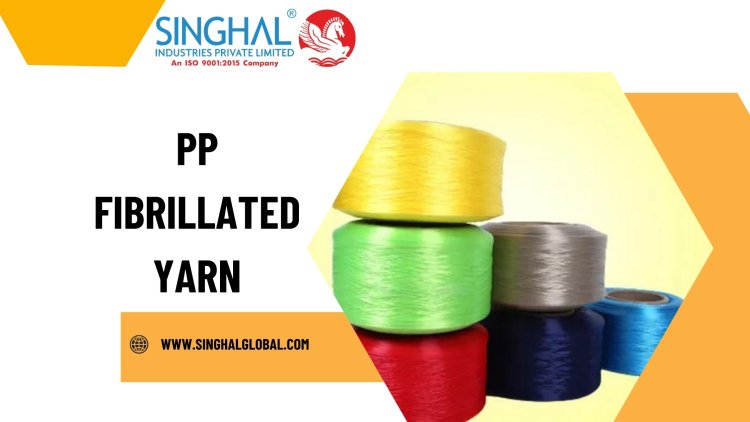Understanding PP Fibrillated Yarn: Uses, Benefits, and Production
In the world of synthetic fibers, PP (polypropylene) fibrillated yarn stands out for its versatility and wide range of applications. But what exactly is this type of yarn, and why has it become so important across various industries?
Share this Post to earn Money ( Upto ₹100 per 1000 Views )

In the world of synthetic fibers, PP (polypropylene) fibrillated yarn stands out for its versatility and wide range of applications. But what exactly is this type of yarn, and why has it become so important across various industries? Let's dive in and unravel the intricacies of PP fibrillated yarn, from its composition and benefits to its production process and leading PP Yarn Manufacturers in india.
What is PP Fibrillated Yarn?
PP fibrillated yarn is made from polypropylene, a thermoplastic polymer known for its strength and durability. The term "fibrillated" refers to the process by which the yarn is produced, involving the creation of fine, net-like structures within the fibers. This unique structure enhances the yarn's overall performance, making it suitable for a wide array of uses.
When compared to other types of yarn, PP fibrillated yarn offers distinct advantages. Unlike natural fibers, it resists moisture, chemicals, and UV degradation. Compared to other synthetic fibers, it often comes out on top in terms of cost-effectiveness and ease of production.
Uses of PP Fibrillated Yarn
The uses of PP fibrillated yarn span across several sectors, each benefiting from its unique properties.
Agricultural Applications
Crop Support: Farmers use PP fibrillated yarn to create support structures for plants, helping them grow vertically and maximizing space.
Fencing: It is also used in agricultural fencing, providing a durable and long-lasting solution that can withstand various weather conditions.
Industrial Applications
Packaging: In the industrial sector, PP fibrillated yarn is essential for creating strong, lightweight packaging materials.
Ropes and Nets: Its strength and durability make it ideal for manufacturing ropes and nets used in fishing, shipping, and other industries.
Domestic Applications
Carpets and Mats: In homes, PP fibrillated yarn is a popular choice for carpets and mats due to its softness and resilience.
Upholstery: It is also used in upholstery, offering a cost-effective and durable fabric option for furniture.
Benefits of PP Fibrillated Yarn
The popularity of PP fibrillated yarn can be attributed to several key benefits:
Durability
One of the standout features of PP fibrillated yarn is its durability. It resists wear and tear, making it ideal for both heavy-duty industrial applications and everyday domestic uses.
Cost-Effectiveness
Compared to many other materials, PP fibrillated yarn is highly cost-effective. Its production process is efficient, and the raw materials are relatively inexpensive, leading to lower overall costs.
Environmental Benefits
Polypropylene is recyclable, and using PP fibrillated yarn can contribute to sustainability efforts. Many manufacturers are now focusing on producing eco-friendly versions of this yarn to minimize environmental impact.
Production Process of PP Fibrillated Yarn
The production of PP Filament Yarn Manufacturers involves several stages, each crucial for ensuring the quality and performance of the final product.The primary raw material used is polypropylene resin. This is a versatile and widely available thermoplastic polymer.
Manufacturing Steps
Extrusion: The polypropylene resin is melted and extruded through a spinneret to form continuous filaments.
Fibrillation: The extruded filaments undergo a fibrillation process, where they are mechanically split to create a network of fine, net-like structures.
Winding: Finally, the fibrillated yarn is wound onto spools, ready for distribution and use.
Quality Control Measures
To ensure the yarn meets industry standards, rigorous quality control measures are in place. These include tests for tensile strength, elongation, and resistance to environmental factors.
Leading PP Yarn Manufacturers
Several manufacturers around the world are known for producing high-quality PP fibrillated yarn. Key players in the global market include companies like LyondellBasell, ExxonMobil, and SABIC, known for their advanced production techniques and commitment to quality. India is home to several prominent PP Yarn Manufacturers, with Singhal Industries being a notable example. Known for their innovative approaches and high-quality products, Singhal Industries has established itself as a leader in the market.
Conclusion
PP fibrillated yarn is a versatile and valuable material with applications across agriculture, industry, and domestic settings. Its durability, cost-effectiveness, and environmental benefits make it a preferred choice for many. As technology advances, we can expect even more innovative uses and improvements in the production of this remarkable yarn.
FAQs
What is the difference between PP fibrillated yarn and PP filament yarn?
PP fibrillated yarn is mechanically split to create a network of fine structures, while PP filament yarn consists of continuous, unbroken filaments. This structural difference affects their applications and properties.
How is PP fibrillated yarn environmentally friendly?
PP fibrillated yarn is recyclable, and many manufacturers are focusing on producing eco-friendly versions. Its production process also tends to have a lower environmental impact compared to some other materials.
Can PP fibrillated yarn be used in extreme weather conditions?
Yes, PP fibrillated yarn is resistant to moisture, chemicals, and UV degradation, making it suitable for use in various weather conditions.
Who are the top PP filament yarn manufacturers?
Top manufacturers include LyondellBasell, ExxonMobil, and SABIC, among others. In India, Singhal Industries is a leading name in the market.
What are the main advantages of using PP fibrillated yarn in agriculture?
The main advantages include its durability, resistance to environmental factors, and cost-effectiveness, making it ideal for crop support and fencing applications.















